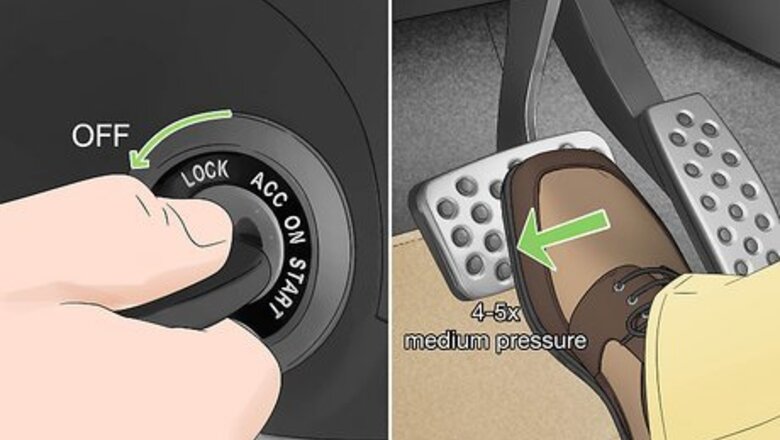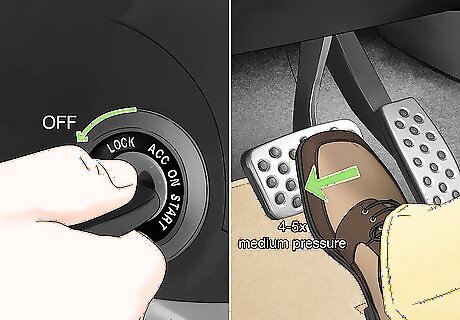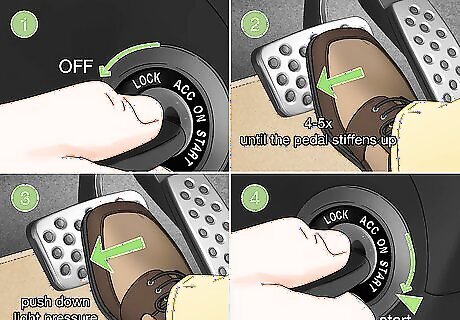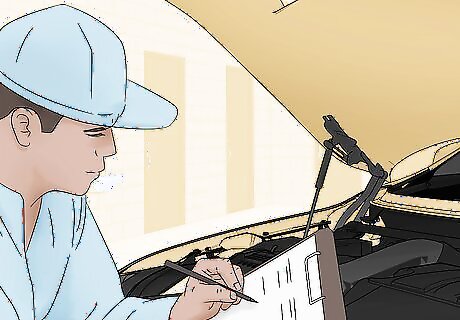
views
- To perform an easy test, turn off the car and pump the brakes 4-5 times until the brake pedal stiffens up. Then, push down the pedal and start the car.
- Check for a slight give underfoot. If the brake pedal stays stiff without giving slightly, the brake booster may be failing.
- Bring your car to a mechanic as soon as possible to get the booster fixed or replaced. Don't try to do it yourself unless you have experience.
Brake Booster Tests

Basic Operational Test Turn the engine off and pump the brake pedal 4-5 times with medium pressure. After 2 pumps, the brake pedal should stiffen noticeably; after 4 or 5 pumps, it should be hard to press down. If the pedal gets stiff immediately, or after only 1 pump, there may be a vacuum leak or a low level of engine vacuum affecting the booster's functionality. If the booster fails the test: Inspect the vacuum supply hose that goes to the booster for kinks, cracks, or damage. If you don't see any visible issues, move on to the vacuum supply test.

Hard Brake Pedal Test Turn off the ignition and pump the brakes 4-5 times until the pedal stiffens up. Once the brake is hard, push down on the pedal with light pressure and start the car. If the brake pedal gives slightly under your foot and stiffens up again, the brake booster is fine. If the brake pedal stays stiff and doesn’t drop or give under your foot, the booster may be failing. If the booster fails the test: Check the power steering system to see if the problem is the pump or the booster (if you know how). Otherwise, bring your car to a mechanic to diagnose and fix the issue.

Vacuum Supply Test Turn off the ignition and pump the brake pedal 4-5 times to deplete the booster reserve. Connect a vacuum gauge to the vacuum supply hose. Then, start the engine and let the car idle for a few minutes while you monitor the vacuum gauge. A normal reading is between 15” and 20” Hg (50 and 70 kpa) at idle. If your reading is 16 or lower: Check the vacuum hose for kinks, clogs, and damage. The hose could also just be worn out and needs to be replaced, so take the car to a mechanic for evaluation. If the hose looks fine, you may have a mechanical problem like leaky valves, worn rings, an intake manifold vacuum leak, or improper cam timing.

Inlet check valve test Turn the ignition off and pump the brake pedal to deplete the booster reserve. Disconnect the vacuum supply hose from the booster. If your check valve is functioning properly, you should hear a “whoosh” sound when you disconnect the supply hose. If you don’t hear anything when you disconnect the hose: take you car to a mechanic and have the check valve replaced. You can also try blowing into the vacuum supply hose once you disconnect it. If air passes through the valve into the booster, the valve needs to be replaced. The check valve is on the brake booster. Consult your car’s owner manual if you aren’t sure where to find it.
Symptoms

The main symptom is a stiff brake pedal that’s hard to press down. The brake booster uses engine vacuum and pressure to stop your car when you press down on the brake pedal. When a brake booster is malfunctioning, your brakes won't be as responsive and you’ll have to push down much harder on the pedal to stop the car. Other common symptoms include: High brake pedal position Increased braking distance Activated warning lights on your dash Fluid leakage Poor engine function Failed power steering
Driveability
It’s likely safe to drive the car to a mechanic or back home, but that’s it. A bad brake booster is something that needs to be fixed ASAP. When a booster is failing, the brake pedal will get harder and harder to press down. Your brakes won't respond as quickly as you need them to, which is dangerous.
Replacement

A qualified mechanic should replace a bad brake booster. Your vehicle’s braking system is quite complex; if you make even a minor mechanical error while you're working on it, your car could become extremely dangerous to drive. Err on the side of caution and get professional vehicle maintenance from a licensed mechanic rather than fixing the booster yourself.
Cost

The average cost for brake booster replacement is between $325-$1,250. The labor itself usually costs between $100-$200, so the rest of the possible cost really depends on which parts need to be fixed or replaced. Cheaper parts (like a replacement vacuum hose) might cost as little as $100, but others can be more expensive. It also depends on the make and model of your car; if you have a foreign sports car, those parts have to be ordered and tend to cost more.
Function

The brake booster amplifies force applied to the brake pedal to slow or stop a vehicle. Your car's brake booster is a black cylinder that sits between the brake pedal and master cylinder in the back area of the engine case. A flexible diaphragm divides the booster into a front and rear chamber and creates a tight seal between them. A thick vacuum hose connects the front chamber to the intake manifold. When the driver presses down on the brake pedal, the booster uses atmospheric pressure and a vacuum to multiply the force and facilitate effective braking. A brake booster may also be referred to as a: Power brake booster Power brake system Brake power booster Vacuum booster


















Comments
0 comment